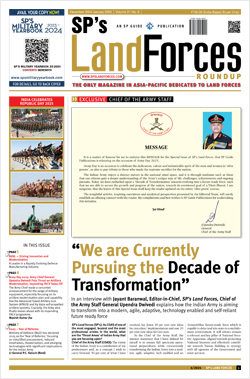INDIAN ARMED FORCES CHIEFS ON OUR RELENTLESS AND FOCUSED PUBLISHING EFFORTS

The insightful articles, inspiring narrations and analytical perspectives presented by the Editorial Team, establish an alluring connect with the reader. My compliments and best wishes to SP Guide Publications.

"Over the past 60 years, the growth of SP Guide Publications has mirrored the rising stature of Indian Navy. Its well-researched and informative magazines on Defence and Aerospace sector have served to shape an educated opinion of our military personnel, policy makers and the public alike. I wish SP's Publication team continued success, fair winds and following seas in all future endeavour!"

Since, its inception in 1964, SP Guide Publications has consistently demonstrated commitment to high-quality journalism in the aerospace and defence sectors, earning a well-deserved reputation as Asia's largest media house in this domain. I wish SP Guide Publications continued success in its pursuit of excellence.
- MoD initiates comprehensive review of Defence Acquisition Procedure 2020, pushes for defence reforms
- G7: The Swansong
- Kalinga Connect: South Asia to Polynesia
- Must Credit DRDO for Operation Sindoor, now what is next for defence R&D?
- The layered Air Defence systems that worked superbly, the key element of Operation Sindoor
- Operation Sindoor | Day 2 DGMOs Briefing
- Operation Sindoor: Resolute yet Restrained
Artillery Capability of OFB
No battle or war was fought by the armies of East India Company, the British Empire or independent India where the arms, ammunition and equipment supplied by the Ordnance Factories did not play a crucial role. Now, OFB is leading the clarion call of Prime Minister Modi for “Atmanirbhar India” by indigenous efforts to ‘Make in India’.
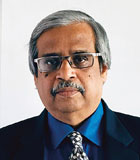 | The Author is Deputy Director General, Corporate Communication and HRD, Ordnance Factory Board |
Artillery pro duction in the Ordnance Factories began in the 19th century and has continued till today. From the initial brass and iron guns and iron howitzers to rifled cannon to horse and field artillery in 1905 and the 4.5” howitzer in 1913.
In 1920 the manufacturing of the 3.7” howitzer commenced and was established by 1925. This saw extensive use in the Second World War, the Kashmir operations and in the wars of 1962, 1965 and 1971. Even during the Kargil Operation it was used in the direct firing mode. The 106mm RCL, used so effectively in the 1965 war, and the 75/24 howitzers were also productionised. The indigenisation of the 84mm Rocket Launcher, the manufacture of 105m IFG/LFG, 120mm and 81mm mortars, the L-70 anti aircraft gun and more recently the indigenisation of the A.K. 630 Naval Guns are all significant achievements of the Ordnance Factories. No battle or war was fought by the armies of East India Company, the British Empire or the independent Indian nation where the arms, ammunition and equipment supplied by the Ordnance Factories did not play a crucial role.

By the end of the 20th century, OFB was making spare barrels and other spare parts of the 155mm 39 calibre Bofors Guns imported from A.B Bofors of Sweden.
These guns, which wreaked havoc on the enemy during the Kargil operations were supported and maintained by OFB manufactured spare parts.
It is against this background, experience and technological expertise that the twin successes of “Dhanush” and “Sharang” have to be understood.
The “ Dhanush” is a 155mm x 45 calibre modern artillery gun system which is a qualitatively and technologically superior weapon system as compared to the 155mm x 39 calibre Bofors Gun.
Not only does it have a longer and metallurgically re-engineered barrel, a new muzzle brake and a larger chamber volume necessitated by the longer barrel, but mechanical and electronic upgrades make it an entirely different weapon on a number of criteria such as:
- Range: A new barrel design and a modified double muzzle brake (MDBMB) have enhanced the range from 27 to 38 Km. The MDBMB limits the stresses on the structure to 155/39 levels.
- Charge: The modification of the loading trough and the loading tray enables “Dhanush” to accommodate the larger diameter of the bi-modular charge system (BMCS).
- Laying: “Dhanush” has an auto laying system based on the Fire Control Computer system as compared to the manual system of the Bofors Gun.
- Sighting System: “Dhanush” has an Advanced Gun Sighting system with a Day camera (CCD), a night camera, a laser range finder (LRF) and NFOV and WFOV as compared to the optical day and night sights of the Bofors Gun.
- Ballistic Calculation: “Dhanush” has an on board Advanced Tactical Computer as distinct from Bofors where the ballistic calculations are done at the command post.
- Gun Recording: “Dhanush” has an Inertial Navigation System (INS) and a GPS as against the theodolite based system of the Bofors.
- Gun Positioning: “Dhanush” has an advanced Gun Alignment and Positioning System (AGAPS) which relies on the INS, GPS, CPU and an odometer.
- Muzzle Velocity Recording: “Dhanush” has an on board muzzle velocity recorder (MVR) as distinct from the offboard system of Bofors.
- Back up Sight: “Dhanush” has a direct and indirect sighting system based on a day and night sight (RS420) and an indirect sight 104 developed by Ordnance factory, Dehradun in addition to the Electronic Sighting System.
The “Sharang” on the other hand is a cost effective up gunned version of the old 1950s vintage 130mm Soviet guns to 155mm x 45 calibre.
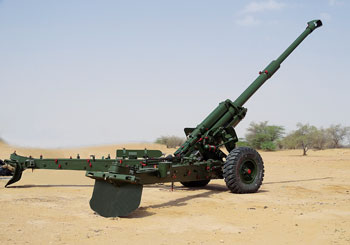
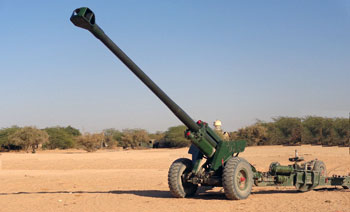
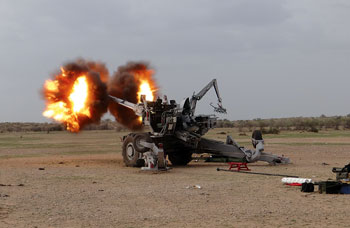
The success of “Sharang” grew out OFB’s success in upgrading the T-55 tank guns in erstwhile Yugoslavia in the 1980-1990. Around the same time the inadequacies of the limited range of 27 km of the 130mm gun came to be increasingly realised. Attempts at upgradation by Soltam Systems of Israel were unsuccessful and when the first guns were supplied in 2002 obturation failures, affecting accuracy, consistency and sustained use began to be observed.
The OFB’s solution of up-gunning was a low cost option to convert it to an all terrain, all weather, accurate gun system capable of firing the full range of 155mm in – service ammunition. For this the gun was equipped with manual loading and pneumatic ramming features. The sighting system of the gun was retained for reasons of cost effectiveness and simplicity.
The solution finally submitted in the field evaluation trials (FET) proved to be superior to those fielded by two private sector firm who had tied up with OEMs, in the crucial areas of maximum range, direct firing capability, accuracy and consistency. It was a result of this that OFB bagged the order of up-gunning 300 M-46 130mm Guns to 155mm x 45 calibre.
The OFB today is recognised as an OEM of repute with in-house capability of design and mass manufacture of a modern artillery gun system for the 21st century. The main elements of this capability are as under:
- Design: OFB, over the years has generated large amounts of proprietary data pertaining to design parameters, manufacturing, testing and validation and performance across the entire lifecycle of a large number of artillery guns across all calibers – 155 x 39, 155 x 45, and 155 x 52.
This resource is unique and unparalleled and coupled with in-house domain expertise, honed over years, will drive future developments in the field of artillery in the foreseeable future.
- Metallurgy: The Ordnance Factories have been manufacturing world class weapons grade steel for artillery, tanks, mortar barrels and trails at the Metal and Steel Factory at Ishapore for more than a century.
In designing the barrel of the “Dhanush” and later the 155 x 52 calibre Mounted Gun System, the methodology of the Bofors 39 calibre – considered a gold standard the world over – had to be reworked. The OFB designers and metallurgists mastered the methodology and a measure of that success is that the OFB exported 155mm x 52 calibre barrels to BAE for testing purposes which have proved to be comparable, if not superior, to barrels manufactured in Europe.
- Cost Effective Products: OFB’s expertise of effective design, in-house metallurgy, efficient manufacturing protocols, and high levels of quality control provide an ability to turn out extremely cost competitive products. It is significant that both “Dhanush” and “Sharang” are deployable across terrains and battlefield conditions as terrain specific ordnance is very costly.
- Capacity: The end to end capacity for manufacture of Large Calibre Weapons under augmentation by the Large Calibre Weapons (LCW) project will result in the world’s largest capacity for barrels and breech mechanisms produced with high end cutting edge technology.
- Supply Chain: OFB has developed supply chain for specialised ESR steel and major sub-assemblies built in-house as well as vendors in the public and private sectors.
- Proof and Testing: OFB has the entire infrastructure for carrying out Proof testing and other tests for certifying the quality of modern artillery gun systems.





